Did you know that Chinese vegetables are not only delicious but also have a long and rich history in Chinese cuisine? These vegetables are not just limited to the usual suspects like spinach and carrots. In fact, there are hundreds of varieties of Chinese vegetables, each with its own unique flavors and health benefits.
From the popular Chinese cabbage that adds a mild sweetness to dishes, to the crisp and flavorful bok choy that is a staple in many Asian recipes, Chinese vegetables offer a world of culinary possibilities.
In this article, I’ll guide you through the most popular and traditional Chinese vegetables, their uses in cooking, and tips for choosing, preparing, and cooking them. So get ready to explore the diverse and delicious world of Chinese vegetables!
Key Takeaways:
- Chinese vegetables have a long and rich history in Chinese cuisine.
- There are hundreds of varieties of Chinese vegetables, each with its own unique flavors and health benefits.
- Popular Chinese vegetables include Chinese cabbage, bok choy, and Chinese broccoli.
- Chinese vegetables can be prepared using various cooking methods such as stir-frying, steaming, and blanching.
- Incorporating Chinese vegetables into your cooking allows you to explore the diverse and delicious world of Chinese cuisine.
Chinese Cabbage: A Staple in Asian Cooking
Chinese cabbage, also known as Napa cabbage, is a versatile vegetable that plays a significant role in Asian cuisine. With its pale green leaves and mild, sweet flavor, Chinese cabbage adds a delightful crunch and freshness to a variety of dishes.
One of the most popular ways to enjoy Chinese cabbage is in stir-fries. Its tender yet sturdy leaves hold up well when cooked with other ingredients, making it an excellent choice for quick and flavorful meals. Whether you’re preparing a classic stir-fry or experimenting with different flavors, Chinese cabbage adds a delicious and nutritious element to your culinary creations.
In addition to stir-fries, Chinese cabbage is commonly used in soups and pickles. Its crisp texture and subtle sweetness complement the rich and savory flavors in soups, adding both depth and freshness to each spoonful. Pickling Chinese cabbage not only enhances its flavor but also creates a tangy and refreshing condiment that pairs well with various dishes.
For a unique and indulgent twist, Chinese cabbage can be braised to create a dish called creamed cabbage. In this preparation, the tender leaves are cooked in a rich mixture of milk, chicken stock, rice wine, and seasonings. The result is a creamy and flavorful cabbage dish that is both comforting and satisfying.
Chinese cabbage, with its versatility and delicate flavor, is a staple in Asian cooking. From stir-fries to soups and pickles, this leafy green adds a delightful crunch and freshness to a variety of dishes. Don’t forget to try the indulgent creamed cabbage for a unique and delicious treat.
As a visual aid, here’s an image showcasing the vibrant and crisp Chinese cabbage:
Bok Choy: A Crisp and Flavorful Leafy Green
When it comes to leafy greens in Chinese cuisine, bok choy takes the spotlight. This popular vegetable, also known as Chinese cabbage, is cherished for its delightful crunch and vibrant flavor. With its crunchy stalks and dark green leaves, bok choy adds a refreshing element to a variety of dishes.
Bok choy’s mild, slightly sweet flavor pairs well with various cooking methods, making it a versatile ingredient in Chinese cuisine. One of the most common ways to prepare bok choy is through stir-frying. The high heat of the wok allows the vegetable to retain its crispness while developing a delicious char.
Another popular way to enjoy bok choy is in soups. Its leafy greens add a vibrant touch to broths, imparting a subtle sweetness to each spoonful. The tender stalks of bok choy simmer beautifully in a hot pot, infusing the soup with their unique flavor.
Bok choy is also a fantastic choice for braised dishes. Its sturdy texture holds up well during prolonged cooking, allowing it to absorb the rich flavors of the sauce. Whether braised with soy sauce, oyster sauce, or other seasonings, bok choy adds a delightful depth to the dish.
Looking to include more leafy greens in your diet? Bok choy is an excellent choice. Not only does it offer a satisfying crunch, but it is also packed with essential nutrients. From vitamins A and C to fiber and calcium, bok choy contributes to a well-balanced and nutritious meal.
A Simple Stir-Fried Bok Choy Recipe
If you’re looking to enhance your cooking skills and incorporate more bok choy into your diet, here’s a simple stir-fried bok choy recipe to try:
- Wash a bunch of bok choy thoroughly and separate the stalks from the leaves.
- Heat some oil in a wok or large skillet over medium-high heat.
- Add minced garlic and ginger to the hot oil and stir-fry for a minute until fragrant.
- Add the bok choy stalks to the wok and stir-fry for about 2-3 minutes until slightly tender.
- Add the bok choy leaves, a splash of soy sauce, and a drizzle of sesame oil. Stir-fry for another 2 minutes until the leaves are wilted.
- Serve hot and enjoy the crisp and flavorful stir-fried bok choy!
Bok choy is a versatile and nutritious leafy green that can elevate your cooking. Whether stir-fried, added to soups, or braised in savory sauces, bok choy adds a delightful crunch and subtle sweetness to any dish. So go ahead, grab some bok choy from your local market, and explore the endless possibilities it offers in your kitchen.
Chinese Broccoli: A Nutritious and Bitter Green
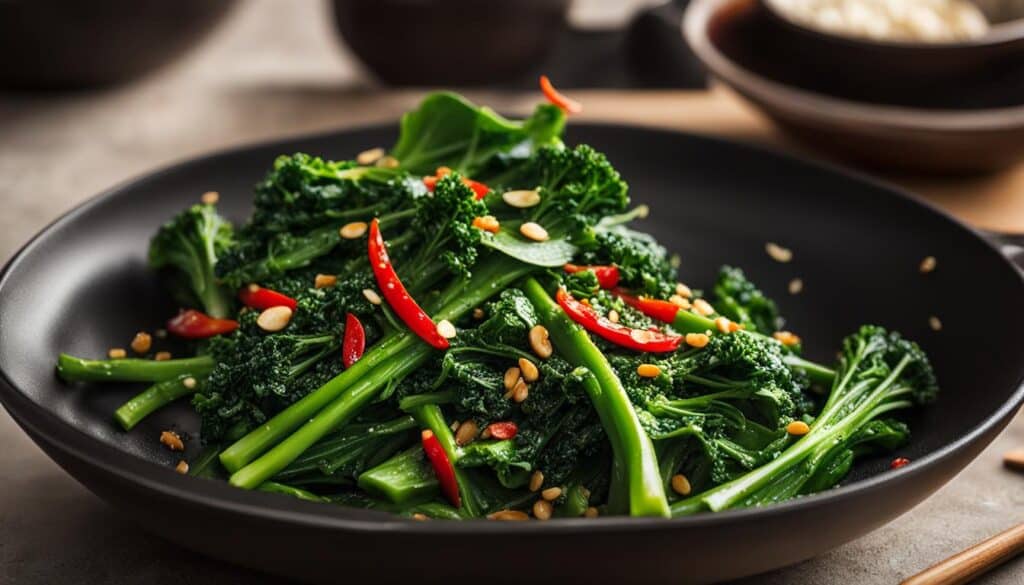
When it comes to leafy green vegetables, Chinese broccoli, also known as Gai Lan, stands out for its unique flavor and nutritional benefits. Despite its slightly bitter taste, Chinese broccoli is a popular choice in Chinese cuisine due to its versatility in various cooking methods.
Stir-frying is a common way to prepare Chinese broccoli, as it helps retain its vibrant color and crisp texture while bringing out its natural flavors. By quickly cooking the vegetable over high heat, you can achieve a deliciously tender result that pairs well with other ingredients in a stir-fry.
Steaming is another popular cooking method for Chinese broccoli, allowing it to retain its nutrients and natural flavors. Steamed Chinese broccoli makes a nutritious side dish or a component in a balanced meal.
The Nutritional Powerhouse
Chinese broccoli is not only tasty but also packed with essential nutrients. It is an excellent source of vitamins A, C, and K, as well as folate and calcium. These nutrients contribute to maintaining healthy skin, supporting the immune system, and promoting bone health.
Furthermore, Chinese broccoli is rich in dietary fiber, which aids in digestion and promotes a healthy digestive system.
“Chinese broccoli’s slightly bitter taste adds depth to dishes, making it a favorite ingredient in many Asian cuisines.”
Incorporating Chinese Broccoli into Your Meals
Chinese broccoli’s versatility allows it to be used in various dishes, from stir-fries to soups. Its unique flavor profile adds complexity to a wide range of recipes.
If you are looking for a simple yet flavorful stir-fry, try combining Chinese broccoli with garlic, oyster sauce, and a protein of your choice, such as shrimp or tofu. The bitterness of the vegetable, when balanced with the savory sauce and the protein’s natural sweetness, creates a harmonious and satisfying dish.
For a lighter option, steamed Chinese broccoli can be enjoyed on its own or drizzled with a simple sauce made from soy sauce, sesame oil, and a sprinkle of toasted sesame seeds. This method brings out the vegetable’s natural flavors and provides a refreshing and nutritious addition to your meal.
With its nutritional benefits and distinct taste, Chinese broccoli is a valuable addition to your culinary repertoire. Whether stir-fried or steamed, this leafy green vegetable offers a delightful combination of flavors and nutrients that can elevate your dishes to new heights.
Bean Sprouts: Crunchy and Versatile
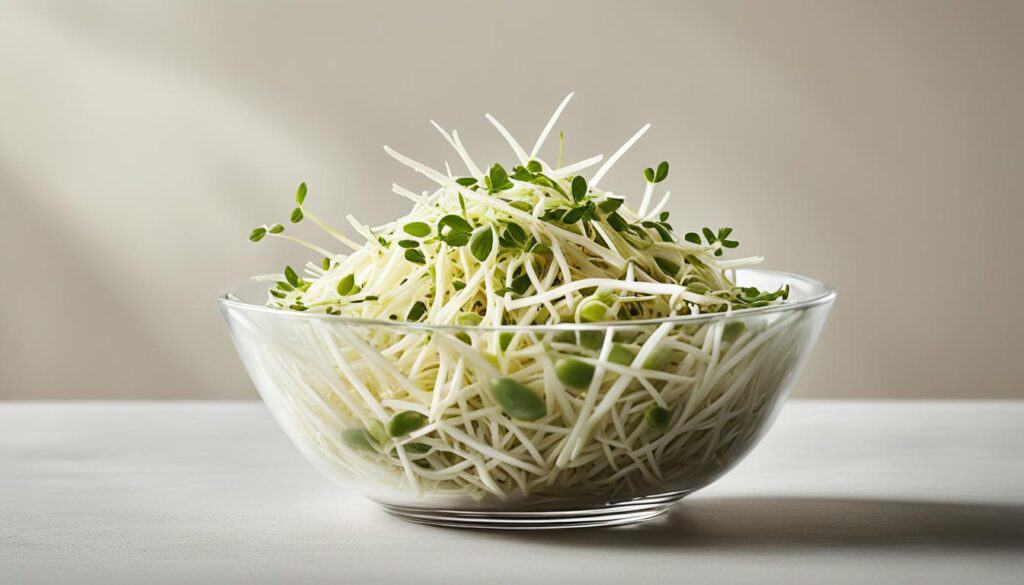
Bean sprouts, such as mung bean sprouts and soybean sprouts, are a popular ingredient in Chinese cuisine. These delicate sprouts, bursting with freshness, add a delightful crunch to a variety of dishes. Whether stir-fried, added to hot pots, or used in soups, bean sprouts bring a unique texture and flavor to your culinary creations.
When stir-frying, bean sprouts retain their crunchiness and absorb the savory flavors of spices, creating a delicious contrast in every bite. Their delicate nature ensures that they cook quickly, making them a convenient and time-saving addition to your stir-fry recipes.
Their versatility extends beyond stir-frying. Bean sprouts are often included in hot pot dishes, where their refreshing crunch complements the rich and flavorful broth. They can also be added to soups, providing a nutritious and satisfying element to the dish.
To unleash the true potential of bean sprouts, it’s essential to use them fresh and properly handle them during preparation. Remember to wash them thoroughly before use, removing any debris. Trim off the roots and any discolored or damaged sprouts to ensure optimal quality and taste.
Explore the possibilities of bean sprouts in your next culinary adventure. Let their crunchy texture and subtle flavor elevate your stir-fries, hot pots, and soups to new heights of deliciousness.
| Benefits of Bean Sprouts | Mung Bean Sprouts | Soybean Sprouts |
|---|---|---|
| Nutritional Value | Rich in vitamins C, E, and K | High in protein and folate |
| Texture | Crunchy and tender | Slightly firmer than mung bean sprouts |
| Flavor | Mild and slightly nutty | Slightly sweeter and nuttier |
| Usage | Stir-fries, hot pots, soups, salads | Stir-fries, hot pots, soups, salads |
Chinese Long Beans: Slim and Crisp
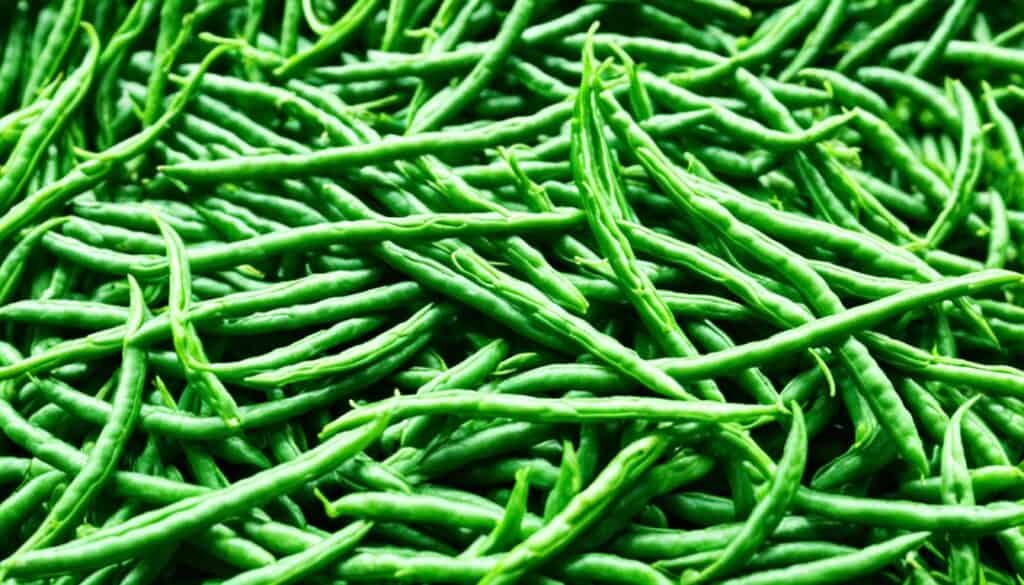
In Chinese cuisine, Chinese long beans, also known as yardlong beans or snake beans, are highly valued for their unique taste and texture. These long and slender beans are a staple ingredient in stir-fries and other Asian dishes.
Their slim shape and crisp texture make Chinese long beans ideal for stir-frying. They retain their crunch even when cooked at high heat, adding a delightful bite to any dish. Whether you’re creating a vegetable stir-fry or a flavorful noodle dish, Chinese long beans are the perfect addition to elevate the flavors and textures.
One of the key features of Chinese long beans is their length, which can reach up to a yard long, hence the name. This makes them a visually striking and versatile vegetable to work with. Whether they are sliced into bite-sized pieces or left whole, Chinese long beans add an interesting visual element to any dish.
“Chinese long beans bring a unique crispness and flavor to stir-fried dishes. Their slender shape and fresh taste make them a favorite ingredient in Chinese cuisine.”
Aside from their distinct texture, Chinese long beans also offer a range of health benefits. They are rich in vitamins and minerals, including vitamin C, vitamin A, and potassium. These nutrients contribute to a healthy immune system, eye health, and overall well-being.
When cooking Chinese long beans, it’s important to properly wash and trim them before use. Remove any ends or blemishes and cut them into desired lengths. For stir-frying, heat a wok or frying pan with oil over high heat. Add the beans and stir-fry them until they are bright green and tender-crisp. Season them with soy sauce, garlic, and other complementary flavors to enhance their taste.
Chinese Eggplant: Smooth and Versatile
When it comes to Chinese cuisine, the Chinese eggplant, also known as aubergine, is an ingredient that stands out for its smooth skin and creamy flesh. This versatile vegetable can be prepared in various ways, including stir-frying and braising, to create dishes that are bursting with flavor.
Stir-frying is a popular cooking method for Chinese eggplant, as it allows the vegetable to retain its firm texture while absorbing the flavors of the sauce and seasonings. Whether you’re craving a quick and healthy weeknight meal or want to add a touch of elegance to your dinner party, stir-fried Chinese eggplant is a go-to option.
Braising, on the other hand, involves slow-cooking the Chinese eggplant in a flavorful liquid, such as soy sauce or broth. This method results in a tender and melt-in-your-mouth experience, perfect for those who prefer a softer texture.
One of my favorite ways to enjoy Chinese eggplant is in a classic dish called “Fish Fragrant Eggplant”. This stir-fried dish combines the flavors of garlic, ginger, and spicy bean paste with the smoothness of the Chinese eggplant. The combination of sweet, sour, and spicy makes for a truly satisfying meal.
To give you a better idea of the versatility of Chinese eggplant, here’s a comparison of two popular cooking methods:
| Stir-Frying Chinese Eggplant | Braising Chinese Eggplant |
|---|---|
| Retains firm texture | Results in a tender texture |
| Absorbs flavors of the sauce and seasonings | Infused with flavorful liquid |
| Quick and easy cooking method | Requires longer cooking time |
As you can see, whether you prefer the crispness of stir-fried Chinese eggplant or the tenderness of braised Chinese eggplant, this versatile vegetable offers endless possibilities in the kitchen.
If you’re looking for a recipe to try, why not experiment with both cooking methods and discover your favorite way to enjoy Chinese eggplant? Don’t be afraid to get creative with different seasonings and sauces to tailor the flavor to your liking.
Next time you’re in the mood for a vegetable dish that is both smooth and versatile, give Chinese eggplant a try. Its creamy texture and ability to absorb flavors make it a star ingredient in Chinese cuisine.
Snow Peas: Sweet and Crunchy

When it comes to adding a delightful burst of freshness to your stir-fries, look no further than snow peas. These delicious and refreshing vegetables are a staple in Chinese cuisine, known for their sweet and crunchy taste. Whether you’re a seasoned cook or just starting out in the kitchen, snow peas are a versatile ingredient that can elevate your dishes to a whole new level.
What sets snow peas apart is their unique texture. The delicate pods are crisp and tender, offering a satisfying crunch with every bite. Whether you enjoy them raw or lightly cooked, snow peas bring a refreshing element to any dish.
A Versatile Ingredient for Stir-Fries
One of the most popular ways to enjoy snow peas is in stir-fries. Their vibrant green color and sweet flavor make them the perfect addition to a variety of stir-fry recipes. Whether you’re whipping up a classic vegetable stir-fry or experimenting with new flavors, snow peas add a delightful crunch and refreshing taste to the dish.
Not only do snow peas bring a burst of flavor to your stir-fries, but they also provide a nutritional boost. These veggies are low in calories, high in fiber, and packed with vitamins and minerals. So you can enjoy your stir-fry guilt-free while reaping the health benefits!
Try These Refreshing Snow Pea Recipes
If you’re looking for some inspiration on how to incorporate snow peas into your meals, here are a few delicious recipes to try:
Snow Pea and Sesame Stir-Fry: This quick and easy recipe combines snow peas with sesame oil, garlic, and soy sauce for a flavorful and refreshing stir-fry.
Snow Pea Salad with Lemon Vinaigrette: This refreshing salad features crisp snow peas, mixed greens, and a tangy lemon vinaigrette for a light and refreshing side dish.
Snow Pea and Shrimp Stir-Fry: This protein-packed stir-fry pairs tender shrimp with crunchy snow peas, creating a balanced and satisfying meal.
“Snow peas bring a burst of freshness and crunch to any dish. Their sweet flavor and crisp texture make them a versatile ingredient in Chinese cuisine.”
So the next time you’re looking to add a refreshing element to your stir-fries or elevate your salads, don’t forget to pick up some snow peas. These sweet and crunchy vegetables will take your dishes to the next level and leave you craving for more.
Choosing, Preparing, and Cooking Chinese Vegetables
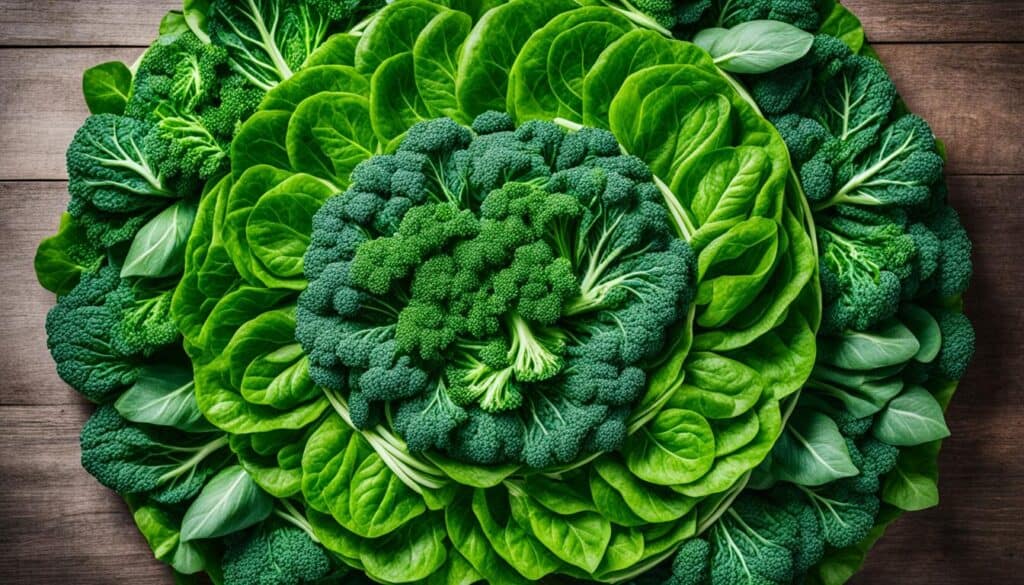
When it comes to cooking Chinese vegetables, the journey starts with selecting the freshest ingredients. Choosing high-quality Chinese vegetables ensures that your dishes are bursting with flavor and essential nutrients.
Before cooking, it’s important to give the vegetables a thorough wash, removing any dirt or impurities. This step ensures that your dishes are not only delicious but also safe to consume. If needed, trim the vegetables to remove any tough or undesirable parts.
Once the Chinese vegetables are cleaned and prepped, it’s time to explore the various cooking methods that bring out their unique flavors and textures.
Stir-Frying:
Stir-frying is a popular and versatile cooking method for Chinese vegetables. It involves quickly cooking the vegetables in a hot pan or wok with minimal oil. This technique preserves the vibrant colors, crunchy textures, and natural flavors of the vegetables.
Steaming:
Steaming is another excellent method for preparing Chinese vegetables. This gentle cooking technique helps to retain the vegetables’ nutrients while keeping them tender and moist. Simply place the vegetables in a steaming basket or tray, and steam them over boiling water until they reach the desired doneness.
Blanching:
Blanching is a brief cooking process that involves submerging Chinese vegetables in boiling water for a short time before quickly cooling them in ice water. This method helps to preserve the vibrant colors and crisp textures of the vegetables. Blanching is often used as a preparation step for stir-frying or as a way to enhance the presentation of vegetables in salads or appetizers.
By mastering these cooking methods, you can unlock the full potential of Chinese vegetables in your culinary creations. Whether you’re stir-frying, steaming, or blanching, each technique offers a unique way to showcase the natural beauty and flavors of these versatile vegetables.
Conclusion
Chinese vegetables offer a world of flavors and culinary possibilities. With their unique tastes and textures, they are an essential part of Chinese cuisine, adding depth and variety to every dish. Whether you’re a seasoned cook or just starting your culinary journey, incorporating Chinese vegetables into your cooking will allow you to explore the diverse and delicious world of Chinese cuisine.
Not only do Chinese vegetables contribute to the overall flavors of a dish, but they also provide numerous health benefits. Packed with essential nutrients, vitamins, and minerals, these vegetables support a balanced and nutritious diet. So, not only can you enjoy the delectable flavors, but you can also nourish your body in the process.
So why wait? Head to your local grocery store or farmers market and pick up some Chinese vegetables to add excitement to your meals. From the crispness of bok choy to the versatility of Chinese cabbage, the possibilities are endless. Explore the flavors, experiment with different cooking methods, and unlock the secrets of Chinese cuisine in your own kitchen. Your taste buds will thank you!

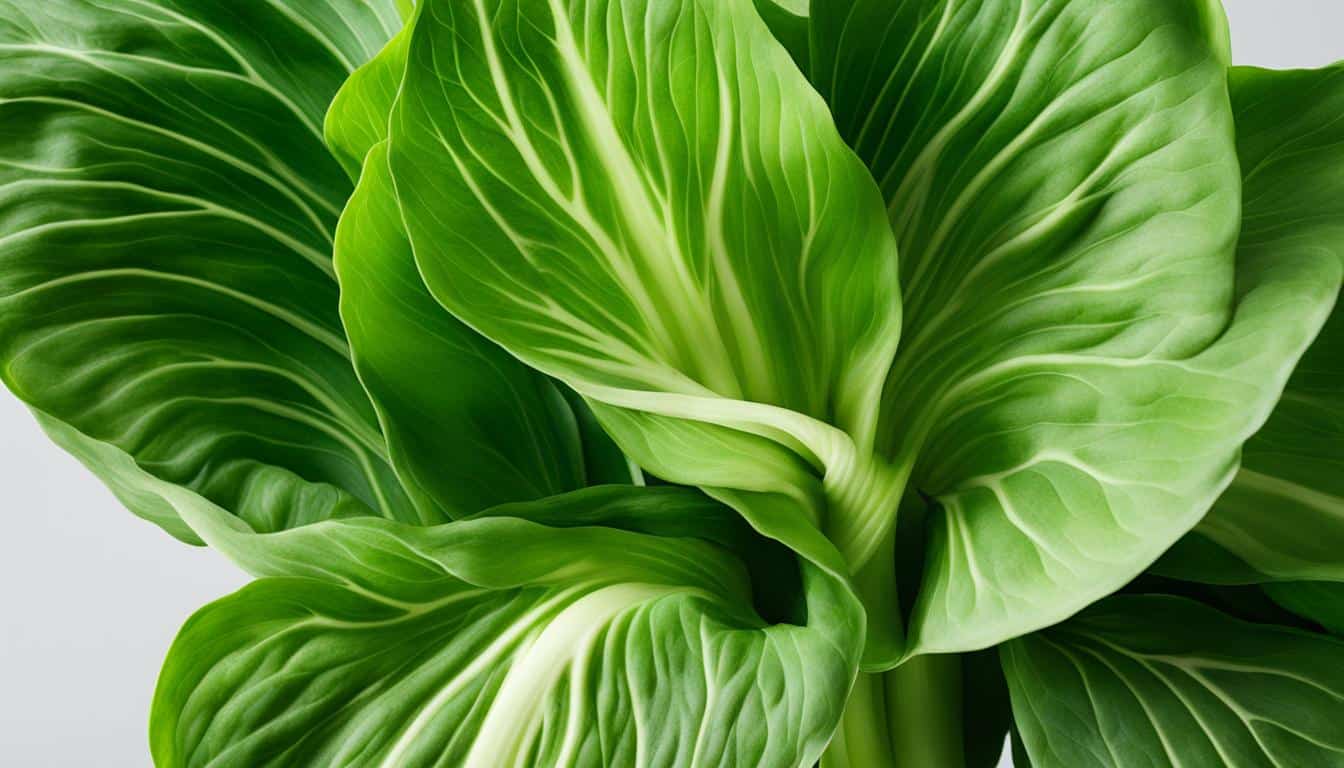



Leave a Reply